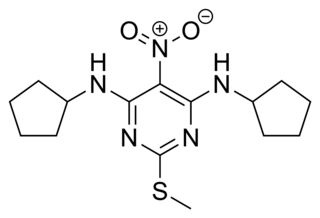
Ibotenic acid or (S)-2-amino-2-(3-hydroxyisoxazol-5-yl)acetic acid, also referred to as ibotenate, is a chemical compound and psychoactive drug which occurs naturally in Amanita muscaria and related species of mushrooms typically found in the temperate and boreal regions of the northern hemisphere. It is a conformationally-restricted analogue of the neurotransmitter glutamate, and due to its structural similarity to this neurotransmitter, acts as a non-selective glutamate receptor agonist. Because of this, ibotenic acid can be a powerful neurotoxin, and is employed as a "brain-lesioning agent" through cranial injections in scientific research.

Muscimol is one of the principal psychoactive constituents of Amanita muscaria and related species of mushroom. Muscimol is a potent, selective agonist for the GABAA receptors and displays sedative-hypnotic, depressant and hallucinogenic psychoactivity. This colorless or white solid is classified as an isoxazole.

A pharmacophore is an abstract description of molecular features that are necessary for molecular recognition of a ligand by a biological macromolecule. IUPAC defines a pharmacophore to be "an ensemble of steric and electronic features that is necessary to ensure the optimal supramolecular interactions with a specific biological target and to trigger its biological response". A pharmacophore model explains how structurally diverse ligands can bind to a common receptor site. Furthermore, pharmacophore models can be used to identify through de novo design or virtual screening novel ligands that will bind to the same receptor.
GABAB receptors (GABABR) are G-protein coupled receptors for gamma-aminobutyric acid (GABA), therefore making them metabotropic receptors, that are linked via G-proteins to potassium channels. The changing potassium concentrations hyperpolarize the cell at the end of an action potential. The reversal potential of the GABAB-mediated IPSP is –100 mV, which is much more hyperpolarized than the GABAA IPSP. GABAB receptors are found in the central nervous system and the autonomic division of the peripheral nervous system.
A structural analog, also known as a chemical analog or simply an analog, is a compound having a structure similar to that of another compound, but differing from it in respect to a certain component.

Phenibut, sold under the brand names Anvifen, Fenibut, and Noofen among others, is a central nervous system depressant with anxiolytic effects, and is used to treat anxiety, insomnia, and for a variety of other indications. It is usually taken by mouth as a tablet, but may be given intravenously.
Isonipecotic acid is a heterocyclic compound which acts as a GABAA receptor partial agonist.

Gaboxadol, also known as 4,5,6,7-tetrahydroisoxazolo(5,4-c)pyridin-3-ol (THIP), is a conformationally constrained derivative of the alkaloid muscimol that was first synthesized in 1977 by the Danish chemist Povl Krogsgaard-Larsen. In the early 1980s gaboxadol was the subject of a series of pilot studies that tested its efficacy as an analgesic and anxiolytic, as well as a treatment for tardive dyskinesia, Huntington's disease, Alzheimer's disease, and spasticity. It was not until 1996 that researchers attempted to harness gaboxadol's frequently reported sedative "adverse effect" for the treatment of insomnia, resulting in a series of clinical trials sponsored by Lundbeck and Merck. In March, 2007, Merck and Lundbeck cancelled work on the drug, citing safety concerns and the failure of an efficacy trial. It acts on the GABA system, but in a different way from benzodiazepines, Z-Drugs, and barbiturates. Lundbeck states that gaboxadol also increases deep sleep. It is, however, not reinforcing like benzodiazepines are.
The Retinoic Acid-Inducible orphan G-protein-coupled receptors (RAIG) are a group of four closely related G protein-coupled receptors whose expression is induced by retinoic acid.

γ-Amino-β-hydroxybutyric acid (GABOB), also known as β-hydroxy-γ-aminobutyric acid (β-hydroxy-GABA), and sold under the brand name Gamibetal among others, is an anticonvulsant which is used for the treatment of epilepsy in Europe, Japan, and Mexico. It is a GABA analogue, or an analogue of the neurotransmitter γ-aminobutyric acid (GABA), and has been found to be an endogenous metabolite of GABA.

G-protein coupled receptor family C group 5 member C is a protein that in humans is encoded by the GPRC5C gene.

Gabaculine is a naturally occurring neurotoxin first isolated from the bacteria Streptomyces toyacaensis, which acts as a potent and irreversible GABA transaminase inhibitor, and also a GABA reuptake inhibitor. Gabaculine is also known as 3-amino-2,3-dihydrobenzoic acid hydrochloride and 5-amino cyclohexa-1,3 dienyl carboxylic acid. Gabaculine increased GABA levels in the brain and had an effect on convulsivity in mice.

GS-39783 is a compound used in scientific research which acts as a positive allosteric modulator at the GABAB receptor. It has been shown to produce anxiolytic effects in animal studies, and reduces self-administration of alcohol, cocaine and nicotine.
In pharmacology, a GABA transaminase inhibitor is an enzyme inhibitor that acts upon GABA transaminase. Inhibition of GABA transaminase enzymes reduces the degradation of GABA, leading to increased neuronal GABA concentrations.

CECXG (3'-ethyl-LY-341,495) is a research drug which acts as a potent and selective antagonist for the group II metabotropic glutamate receptors (mGluR2/3), with reasonable selectivity for mGluR3. While it is some five times less potent than LY-341,495 at mGluR3, it has 38x higher affinity for mGluR3 over mGluR2, making it one of the few ligands available that is able to distinguish between these two closely related receptor subtypes.

Clorotepine, also known as octoclothepin or octoclothepine, is an antipsychotic of the tricyclic group which was derived from perathiepin in 1965 and marketed in the Czech Republic by Spofa in or around 1971 for the treatment of schizophrenic psychosis.

Arecaidine is a bio-active alkaloid in areca nuts. It is a competitive GABA uptake inhibitor. Lime is said to hydrolyse arecoline to arecaidine

CI-966 (developmental code name) is a central nervous system depressant acting as a GABA reuptake inhibitor, specifically a highly potent and selective blocker of the GABA transporter 1 (GAT-1) (IC50 = 0.26 μM), and hence indirect and non-selective GABA receptor full agonist. It was investigated as a potential anticonvulsant, anxiolytic, and neuroprotective therapeutic but was discontinued during clinical development due to the incidence of severe adverse effects at higher doses and hence was never marketed.

Homoquinolinic acid (HQA) is a potent excitotoxin which is a conformationally-restricted analogue of N-methyl-D-aspartate (NMDA) and a partial agonist of the main/glutamate site of the NMDA receptor, with some selectivity for NR2B subunit-containing receptors. It is approximately equipotent to NMDA and about five times more potent than quinolinic acid as an agonist of the NMDA receptor. HQA has also been found to label a novel, yet uncharacterized binding site, which can be distinguished from the NMDA receptor with the use of 2-carboxy-3-carboxymethylquinoline (CCMQ), a selective ligand of the uncharacterized site.

Butestrol, or racemic butestrol (rac-butestrol) is a synthetic nonsteroidal estrogen which was never marketed. It is structurally related to diethylstilbestrol and other stilbestrols.















